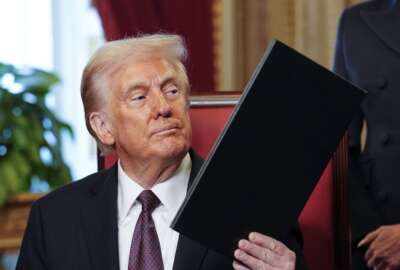A look at the origins of the Defense Innovation Unit
Written by two of the agency's early leaders, Raj Shah and Chris Kirchhoff, a new book details the beginning days of the Defense Innovation Unit.
A new book details the beginning days of the Defense Innovation Unit. Written by two of the agency’s early leaders, Raj Shah and Chris Kirchhoff, Unit X tells the story of those who were there to establish DIU, which acts as a go between Silicon Valley and the Pentagon. One of the main characters is Lauren Dailey, who at the time was DIU’s director of acquisitions, where she discovered how the agency could construct contracts that would be more attractive to tech firms. Federal News Network’s executive producer Eric White recently had the chance to speak with her about it and how everything came together, on the Federal Drive with Tom Temin.
Interview transcript:
Eric White Why don’t we just start from the beginning? It was kind of an interesting path that got you to DIUx. And you know, it’s a small defense agency. How did you find yourself in that position that you just mentioned?
Lauren Dailey I had been working in the Pentagon as a member of the Army acquisition workforce as a civilian, working in ASAALT, which is Army acquisition headquarters, for several years. And I had heard about DIUx and was interested in the mission, right? Hey, we’re gonna try and reconnect DoD with Silicon Valley. And, I knew, as an acquisition person, that was really interesting to me, right? How do we help engage the way that DoD does business with Silicon Valley? And, so, I raised my hand, I volunteered and said, hey, I would love to interview for this job. Interviewed for it, got it, and then moved from D.C. out to San Francisco.
Eric White Alright, so let’s set the scene. You get, at DIUx, as you just mentioned, it is tasked with connecting the Pentagon with Silicon Valley. And, other tech companies, we’ll say. For the purposes of this interview, we’ll just keep referring to it as Silicon Valley. What is it that you see as the initial problem and the disconnect between those two entities?
Lauren Dailey Absolutely. So, when I got there, right, I think I was employee, like, number five or six, maybe. So, we were very, very small, still getting commercial Internet set up in our office, right? So, very scrappy, very startup-like, and for the first, I would say, about six months that I was there, our mission was, hey, we’re gonna go find these really cool tech companies, we’re going to connect them back with DoD customers. Magic is gonna happen. They’re going to work together. It’s going to be amazing. And, obviously, it’s not quite that easy and it doesn’t work that way. And, so, what we found was that a lot of DoD customers were very excited about working with these companies and these technologies, but they just couldn’t get them on contract quickly enough so that the companies wouldn’t lose interest or say, you know what, you’re not really serious, you’re not willing to put your money where your mouth is, we’re gonna go focus our BD efforts on other clients. And, so, as the acquisition lead, right, they turned to me and said, hey, we need to figure out a way to actually get these companies money. We need to be able to get them on contract and do business quickly at the speed of business, at the speed of Silicon Valley. How are we going to do that?
Eric White It’s kind of a different situation for the Pentagon that it’s used to, because usually, it’s the companies that they work for rely on the Pentagon for their business. Not the case with these tech companies that are saying, you know, hey, if we don’t do business with the government, we’ll just go off in another direction. What was it kind of adjusting to that? You know, coming from the Army, where you’re just such a massive cash cow for most of these companies to, yeah, you know, we might do business with you.
Lauren Dailey Well, the way that I thought about it was that DoD has traditionally been a monopsony, right? So, the single buyer of things, like tanks, aircraft carriers, missiles, right? And, so, they’re used to having all of that buying power, right, and using that buying power, that single buyer. But when you look at the commercial technology market in Silicon Valley, not only is DoD not the single buyer, but in a lot of times, they’re not even an important minority buyer. And, so, you’re facing not just different types of technologies that you’re trying to buy, but a fundamentally very different market with different market conditions where you’re in a different market position. And, so, you have to very fundamentally change the way that DoD thinks about doing business with these companies and their place in this market in order for them to be able to effectively work in this ecosystem.
Eric White That brings us up to the point of what we’re talking about today. Enter the commercial solutions opening that you were able to discover through poring through mountains and mountains of acquisition law. Why don’t you tell me about that discovery, and actually kind of define that for us as well?
Lauren Dailey Commercial solutions opening is what I created for DIU. That was using OTA authorities, right? Other Transaction Agreements, which are not new themselves, right? They go back to the to the 1950s. But there was this new language that had come out just that year, that said, hey, if you have a successful prototype OTA, you can move directly into production without having to do another competition. And, so, that was really attractive and interest interesting to us, right? Hey, if we find these promising companies, and we can prototype and demonstrate their capabilities, at least from a contractual perspective, they can move right to scale to production, right? They can hop that valley of death and scale immediately. So, we were really excited about that. But I think it wasn’t just that. It was also, how do we create a business process, that, like I said, mirrors more of what Silicon Valley is used to, right? And there were kind of three fundamental tenets of that that we looked at. One was fast, right? We needed to be able to move quickly. We couldn’t take 12, 18 months to get a particular company and contract. We need to move quickly at the speed of business. Second was flexible, right? These companies in this ecosystem is used to being able to negotiate contracts, right? It can’t be, here’s 100-page government contract, and you have to sign every provision, right? We need to be able to negotiate and make the contract fit the need of what we were buying. And third, and most importantly in my mind, was collaborative, right? Rather than the government setting, here’s all these requirements that we’re going to set all by ourselves, and then give you the detailed requirements, you have to go build that. We wanted to create an environment where the government could say, here’s our problem. And industry could really come and say, here’s all of our different possible solutions. Let’s collaborate together to design the scope of work to design the project. Let’s get the people who know the problem best, right, these warfighters, in the same room with the people that know these solutions best, the engineers from these companies, and have them sit down together and create what this project is. And that’s what the commercial solutions opening allowed us to do.
Eric White We’re speaking with Lauren Dailey. She’s a senior manager with Deloitte, but first and former acquisition director for the Defense Innovation Unit. Yeah, you’re really speaking the Silicon Valley’s language there, because, you know, at least from what I’ve seen and heard about the culture surrounding those tech companies, it’s all about action and getting things moving and avoiding that valley of death, as you mentioned. Can you, and I don’t expect you to know the litany of them, but were there any projects that stick out that you were all were able to help get off the ground using this process?
Lauren Dailey One of the early ones was a company called Shield AI that makes these quadcopters that will fly around inside and spaces and check things out, right.? And this was interesting, because it was a company who was actually trying to sell to DoD, right? A lot, most, obviously, startups are trying to sell primarily to commercial companies. They really knew that they had a DoD use case, and they wanted to sell to us. But they were having trouble before they came to DIU on how to raise money, because all of their investors were saying, no, sorry, you know, this isn’t a good path to revenue, we’re not willing to invest in you because we don’t see DoD as a viable future for our company. We got really excited about their technology, especially in some interesting special operations cases, put them through the process. They competed, they were awarded an OTA from the from our CSO, I want to say within a month, it was pretty quick. And after that, after they were doing that prototype, they were able to take that back to their investors in the venture capital community and say, look, look how quickly we were able to get a contract from DoD. And guess what? There was immediate investment from their investors that came to follow. Because they said they looked at the CSO process and said, oh, DoD actually can move money quickly and willing to partner with these companies. We as investors will also follow up on that. So, that was really validating from, you know, a dual ecosystem perspective.
Eric White You just mentioned kind of the feeling around working with the Pentagon changed. How has CSO had an effect on DIUx’s mission overall? How happy were your superiors when you you showed them this method? Did it make things easier? And you know, if you can, from an outsider perspective, and still an acquisition professional yourself, how, what is it, where has it left DIU today?
Lauren Dailey So, yeah, and you can read about it in Raj and Chris’s new book called Unit X, right, where they they tell the story of this, but once we had the CSO in place, then it was really, you know, floodgates open, we now have a way to actually demonstrate that DoD can put money on contracts in a fast, flexible, collaborative mechanism that can demonstrate we were here to actually work with Silicon Valley. And that really opened the floodgates for all of the work that DIU has done then and since, right,? The vast majority of their projects they put through the CSO still today and then spread even beyond DIU to all other components of DoD, which is really exciting to see.
Eric White Final question, I just want to pick your brain as an acquisition \professional, because since the commercial solutions opening isn’t OTA itself, we’ve actually got you at a good time, because there’s a bit of news about OTAs, what with a recent court ruling saying that they might be liable to bid protests and also there’s a provision in the most recent Senate NDAA saying that they want to create a committee to study the use of OTAs just because of the rising use of them and the way that acquisition press professionals like yourself, like to use them because of that simplicity and moving things faster. What do you see as the future of OTAs? And if changes are made to it, is it still going to be an effective approach for the government overall, to get those business deals moving quicker?
Lauren Dailey In my mind, the tool is only as good as the artist using it, right? We’ve seen OTAs be used really well. We’ve seen them be used really poorly, and to the point where they’re actually slower than traditional processes. On the other hand, we’ve seen amazing contracting officers and acquisition professionals use FAR-based contracts in really unique and creative ways that gets them to act quickly and flexibly and work with these kinds of companies, right? So, I think it’s less about OTA versus FAR and more about how do we help make sure that DoD and our acquisition workforce have the permission to take risks to do something differently, to change the way they fundamentally approach business relationships to work effectively with Silicon Valley and commercial companies that don’t traditionally work with DoD? And no matter what tool you use, as long as you have I think, that approach and that that cultural distinction, I think you’ll be able to create business processes that enable DoD to work effectively with the Valley.
Eric White Yeah. And that’s such a good point, because it does take the workforce, you know, in your mind, having a steady pipeline of creative professionals like yourself entering the acquisition space. What can be done to maintain that and make sure that, like I said, folks like yourself who kind of think outside the box aren’t just going straight to Silicon Valley in places that usually harbor that kind of talent?
Lauren Dailey Absolutely. So, I think it comes down to a couple of things, right? One is risk tolerance, right? And that really comes from leadership throughout all different levels of DoD, and an industry has to be able to say, yes, we want to, we do want to do this differently, and we give our teams permission to do that, right? In the case of the CSO, right? It was Raj and Chris as my immediate supervisors, right, but really all the way up to the Secretary of Defense, who was briefed on this, Ash Carter at the time, and said, this is great. This is what we need and move forward on it, right? So, having that leadership top cover I think helps people feel like they can take risks and do something differently to change the way the DoD does business. So, always exciting to see that.
Eric White Lauren Dailey is a senior manager for Deloitte and former acquisition director for the Defense Innovation Unit. Find this interview at our website, go to federalnewsnetwork.com/federaldrive. You can also subscribe to the Federal Drive wherever you get your podcasts.
Copyright © 2025 Federal News Network. All rights reserved. This website is not intended for users located within the European Economic Area.
Eric White is news anchor and Federal Drive producer at Federal News Network.
Follow @FEDERALNEWSCAST







